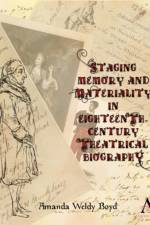av Amanda Weldy Boyd
1 207
"e;Staging Memory and Materiality in Eighteenth-Century Theatrical Biography"e; examines theatrical biography as a nascent genre in eighteenth-century England. This study suggests a visible-but not impermeable-teleology from Thomas Davies to James Boaden in the development of theatrical biography as a professional enterprise. Chapter One explores Davies, the first significant biographer to throw off the shadows of anonymity and weld his own image to his subject, David Garrick. The second chapter traces three biographies of Charles Macklin written by biographers dueling amongst themselves for the right to tell Macklin's story in the post-Davies competitive market. Finally, the third chapter tells the story of the serial biographer James Boaden's attempts to build a professional reputation for himself as a biographer and prominent participatory character in the multiple "e;Lives"e; he tells, including those of John Philip Kemble, Sarah Siddons, Dorothy Jordan, and Elizabeth Inchbald. In each instance of producing a theatrical biography, the author is confronted not only with his duty to represent the actor, but the need to do so in an original, compelling manner that sets his account apart from other contenders and guarantees the permanency of his account as a treasured artifact of the stage rather than a disposable commodity.The willful encouragement of viewing literary materiality as an antidote to ephemeral stage-business leads in turn to the absorption of prior biographical works and letters by authors, and reverberates in their readers' quests to augment their copies of theatrical biographies through adding playbills, marginal notes, etchings, paintings, newspaper clippings, and even funerary souvenirs that not only testified to their interest in the stage, but secured their existence as well by evidence of participation. Thus, the author at once guaranteed the thespian's legacy would live on while hitching his own likelihood of being remembered to the actor. The audience followed suit by adding their own personal touches, forming a palimpsest of participants. Drawing heavily on primary sources, then-contemporary reviews, and archival material in the form of extra-illustrated or "e;scrapbooked"e; editions of the biographies, this book is invested in the ways that the increasing emphasis on materiality was designed to consolidate, but often challenged, the biographer's authority.The book provides an introduction to theatrical biography as an immensely popular genre in the eighteenth century that deserves more scholarly attention. Currently, theatrical biography is usually overlooked or encountered solely in excerpts offered to advance individual research goals; the texts are perceived as repositories of facts or the odd opinion, more akin to a reference work than anything innately artistic. This study's contribution is to read these biographies in context, exploring their participation in a developing poetics of a new artistic subgenre, from the content of the works and the concerns of its authors to the responses that these biographies elicited from their readers.

